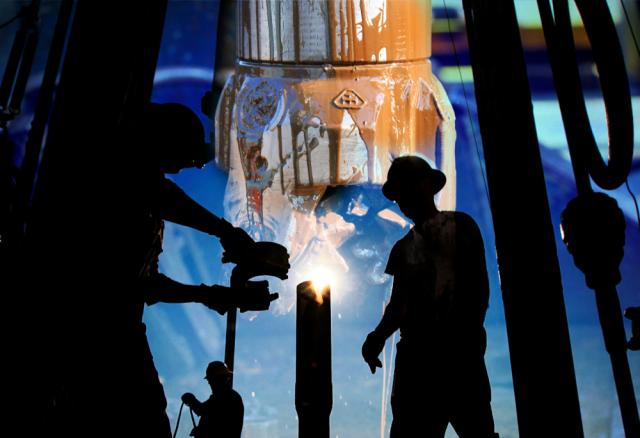
A typical error would be for someone to see a value of boe and assume that each is worth the price of a barrel of oil, which for black oils isn’t a bad assumption. However, as the gas-oil ratio increases, it’s inaccurate. (Source: Hart Energy)
This is an excerpt from the Ralph E. Davis Associates (RED) Weekly E&P Update Newsletter.
Last week, industry colleague Dwayne Purvis raised an interesting point in a LinkedIn post about the use of “barrels of oil equivalent” (boe) metrics. Dwayne’s point, and one that I and many commenters agreed on, is that the standard 6:1:1 ratio of converting million cubic feet (MMcf) of natural gas and barrels of natural gas liquids (NGL) to boe is misleading because the relative prices of natural gas and NGL aren’t close to these ratios. A typical error would be for someone to see a value of boe and assume that each is worth the price of a barrel of oil. For black oils, this isn’t a bad assumption, but as the gas-oil ratio increases, it’s inaccurate. I’ve even seen cases where practically dry gas streams were presented on a boe basis, using the 6:1 ratio, even though the revenue from each boe was a fraction of the oil price. At best, this creates unnecessary confusion.
So why do we use boe (or MMcfe) in the first place? It’s a way to allow us to compare certain metrics like operating cost, development cost, finding cost and others across multiple assets or wells to get a sense of their relative performance. But relative costs aren’t as important as relative margins—that is, why would I care if one field costs twice as much to operate on a per-boe basis if the revenues on a per-boe basis were three times higher? Comparing metrics based on 6:1 boe also requires us to look at revenue on a per-boe basis to understand performance.
Purvis’ recommendation was to adopt a conversion ratio that’s closer to the relative prices (he suggested 20:3:1) to calculate a “barrels of value” metric. I’ve used this approach often in the past, and I think it’s an improvement over the current practice. For example, consider a gas field that operates at $0.50/MMcf and gas sells for $3/MMBtu. The operating cost would be $10/BOV operating cost if the relative prices adhered to the 20:1 ratio. Using the 6:1 ratio, the gas field would have an operating cost of $3/boe and appear to be a more profitable operation.
The challenge, of course, is getting the right ratios. Relative spot prices change over time (NGL can be particularly volatile) and forward price ratios are likely to vary over the life of a project. Although the 20:3:1 ratio isn’t perfect, it’s much more useful for comparisons than the current 6:1 standard, and since the primary purpose of the boe metric is to make comparisons, it seems appropriate to use conversion ratios that make the comparisons more meaningful.
(Final note—readers may wonder where the 6:1 ratio came from in the first place. It was derived from the approximate ratio of heat content in a barrel of oil to a cubic foot of gas. When I started my career, I worked for Shell, and since we were sticklers for detail, we used 5.7, which is closer to the actual value.)
About the Author:
Steve Hendrickson is the president of Ralph E. Davis Associates, an Opportune LLP company. Hendrickson has over 30 years of professional leadership experience in the energy industry with a proven track record of adding value through acquisitions, development and operations. In addition, he possesses extensive knowledge of petroleum economics, energy finance, reserves reporting and data management, and has deep expertise in reservoir engineering, production engineering and technical evaluations. Hendrickson is a licensed professional engineer in the state of Texas and holds an M.S. in Finance from the University of Houston and a B.S. in Chemical Engineering from The University of Texas at Austin. He recently served as a board member of the Society of Petroleum Evaluation Engineers and is a registered FINRA representative.
Recommended Reading
TGS, SLB to Conduct Engagement Phase 5 in GoM
2024-02-05 - TGS and SLB’s seventh program within the joint venture involves the acquisition of 157 Outer Continental Shelf blocks.
2023-2025 Subsea Tieback Round-Up
2024-02-06 - Here's a look at subsea tieback projects across the globe. The first in a two-part series, this report highlights some of the subsea tiebacks scheduled to be online by 2025.
StimStixx, Hunting Titan Partner on Well Perforation, Acidizing
2024-02-07 - The strategic partnership between StimStixx Technologies and Hunting Titan will increase well treatments and reduce costs, the companies said.
Tech Trends: Autonomous Drone Aims to Disrupt Subsea Inspection
2024-01-30 - The partners in the project are working to usher in a new era of inspection efficiencies.
Drilling Tech Rides a Wave
2024-01-30 - Can new designs, automation and aerospace inspiration boost drilling results?





